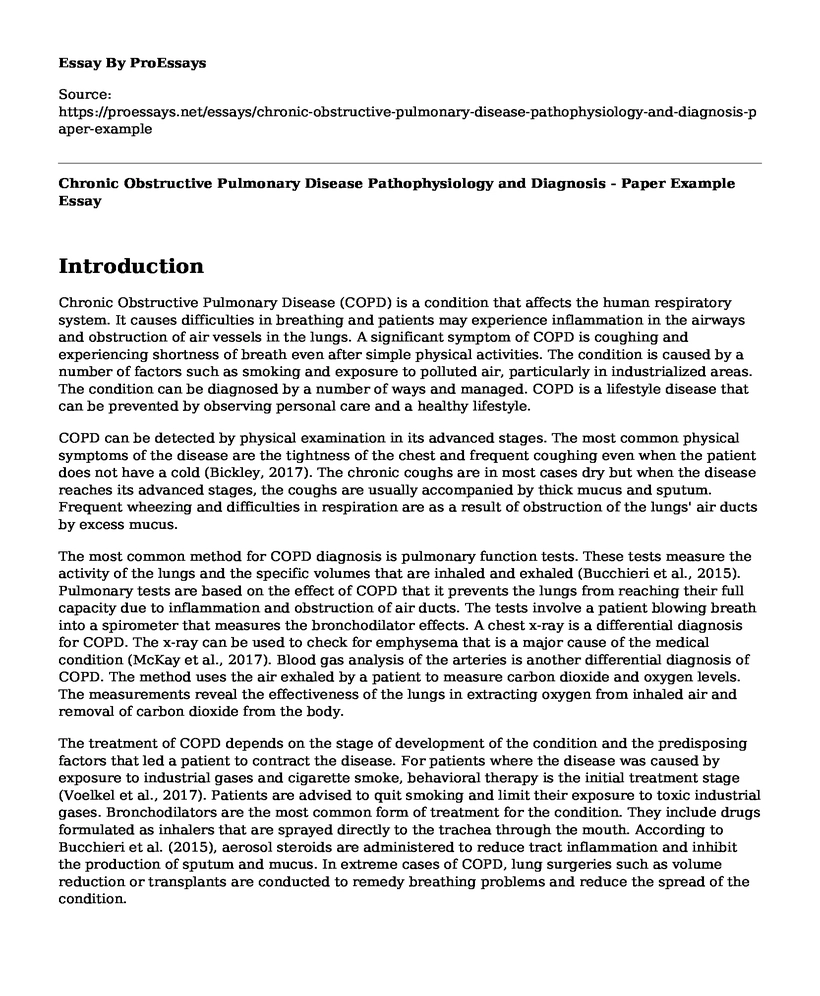Introduction
Chronic Obstructive Pulmonary Disease (COPD) is a condition that affects the human respiratory system. It causes difficulties in breathing and patients may experience inflammation in the airways and obstruction of air vessels in the lungs. A significant symptom of COPD is coughing and experiencing shortness of breath even after simple physical activities. The condition is caused by a number of factors such as smoking and exposure to polluted air, particularly in industrialized areas. The condition can be diagnosed by a number of ways and managed. COPD is a lifestyle disease that can be prevented by observing personal care and a healthy lifestyle.
COPD can be detected by physical examination in its advanced stages. The most common physical symptoms of the disease are the tightness of the chest and frequent coughing even when the patient does not have a cold (Bickley, 2017). The chronic coughs are in most cases dry but when the disease reaches its advanced stages, the coughs are usually accompanied by thick mucus and sputum. Frequent wheezing and difficulties in respiration are as a result of obstruction of the lungs' air ducts by excess mucus.
The most common method for COPD diagnosis is pulmonary function tests. These tests measure the activity of the lungs and the specific volumes that are inhaled and exhaled (Bucchieri et al., 2015). Pulmonary tests are based on the effect of COPD that it prevents the lungs from reaching their full capacity due to inflammation and obstruction of air ducts. The tests involve a patient blowing breath into a spirometer that measures the bronchodilator effects. A chest x-ray is a differential diagnosis for COPD. The x-ray can be used to check for emphysema that is a major cause of the medical condition (McKay et al., 2017). Blood gas analysis of the arteries is another differential diagnosis of COPD. The method uses the air exhaled by a patient to measure carbon dioxide and oxygen levels. The measurements reveal the effectiveness of the lungs in extracting oxygen from inhaled air and removal of carbon dioxide from the body.
The treatment of COPD depends on the stage of development of the condition and the predisposing factors that led a patient to contract the disease. For patients where the disease was caused by exposure to industrial gases and cigarette smoke, behavioral therapy is the initial treatment stage (Voelkel et al., 2017). Patients are advised to quit smoking and limit their exposure to toxic industrial gases. Bronchodilators are the most common form of treatment for the condition. They include drugs formulated as inhalers that are sprayed directly to the trachea through the mouth. According to Bucchieri et al. (2015), aerosol steroids are administered to reduce tract inflammation and inhibit the production of sputum and mucus. In extreme cases of COPD, lung surgeries such as volume reduction or transplants are conducted to remedy breathing problems and reduce the spread of the condition.
Conclusion
COPD is indeed a manageable medical condition. It is caused by factors that can be controlled through healthy living and observation of air hygiene. COPD presents pronounced symptoms that are easy to detect allowing patients to seek medication before the disease reaches its advanced stages. Behavioral therapy is the most effective control measure for the condition. Each person ought to seek medication when they experience any of the COPD symptoms because the condition can escalate and give rise to life-threatening diseases such as Asthma.
References
Bickley, L. (2017). Bates' Guide to Physical Examination and History Taking (ISBN-13:9781469893419 (12th ed.). Lippincott: Philadelphia, PA.
Bucchieri, S., Cuttitta, G., Cibella, F., Alfano, P., Audino, P., Melis, M., & Viegi, G. (2015). C46 How Do You Do It? COPD Diagnosis And Assessment: Airway Obstruction In Primary Care Patients: Need For Implementing Spirometry Use. American Journal of Respiratory and Critical Care Medicine, 191, 1.
McKay, G. J., McCarter, R., Hogg, R. E., Bajaj, M. P. K., Burrage, D., Ruickbie, S., ... & Dodd, J. W. (2017). Retinal Microvascular Changes In People With COPD Compared To Age-Matched Smokers Without COPD. In A14. COPD: SYSTEMS BIOLOGY AND COMORBIDITY (pp. A1012-A1012). American Thoracic Society.
Voelkel, N. F., Mizuno, S., & Cool, C. D. (2017). The Spectrum of Pulmonary Disease in COPD. In COPD (pp. 195-207). Springer, Berlin, Heidelberg.
Cite this page
Chronic Obstructive Pulmonary Disease Pathophysiology and Diagnosis - Paper Example. (2022, Jun 19). Retrieved from https://proessays.net/essays/chronic-obstructive-pulmonary-disease-pathophysiology-and-diagnosis-paper-example
If you are the original author of this essay and no longer wish to have it published on the ProEssays website, please click below to request its removal:
- Social Work Staff and Students Involved in the Social Work Profession in Institutions of Higher Learning
- Benchmark - Individual Client Health History and Examination Essay
- A Chronic Care Model to Curb Chronic Conditions Essay Example
- Essay Sample on Public Health Perspective
- Technology and Cancer Annotated Bibliography
- Fact Sheet on Health Care Insurance Plans - Paper Example
- Nurses' Mental and Physical Health: Challenges and Implications - Research Paper







